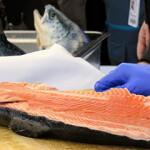Optimism mounts for a strong Gulf of Alaska tanner crab season

There’s good news for crab fishermen in the Gulf of Alaska.
A huge cohort of tanner crab that biologists have been tracking in the Westward region for three years showed up again in this summer’s survey.
“We were optimistic, and we did find them again. Pretty much all the way across the board from Kodiak all the way out to False Pass, we found those crab and in good quantity,” Nat Nichols, area manager for the Alaska Department of Fish and Game at Kodiak, said.
The bairdi tanners are the larger cousins of snow crab (opilio tanners) found in the Bering Sea.
“The very, very rough preliminary numbers look like we've at least hit the minimum abundance thresholds in all three areas of Kodiak, Chignik, and the South Peninsula. So we're excited about that,” Nichols said.
The last tanner opener was in 2020 for 400,000 pounds, the minimum abundance number for a district to have a fishery. A fleet of 49 boats participated in that fishery and averaged over USD 4.00 (EUR 3.41) per pound for the harvestable male crabs that typically weigh between two and four pounds each.
“A tanner crab is getting to be legal sized around age four or five, and then they start to die of natural causes or age out of the population by around seven or eight,” Nichols explained. “Once they start to become legal, we can expect them to hang around for potentially three years, and there'll be more small crab behind them, so you can kind of think of this as the front edge.”
The new cohort, Nichols said, is one of the largest ever. It appears to be made up of two big year classes, with a broad range of sizes that could support several years of fishing.
“In 2019, the estimate was 223 million, and then in 2020, it was down to 108 million. Every year, that number gets smaller, because there’s pretty high mortality on smaller crab. Anybody who’s cut open a halibut stomach knows that,” Nichols said. “And a lot of those are females, so they won’t be in the fishery. But the male crab are getting bigger and approaching legal size. So even though you're seeing estimates go down quite a bit, it's still going to turn into a pretty good number of legal crab in the water.”
Several more regulatory calculations must still be met as managers move their way through the survey data before a 2022 tanner fishery gets a green light.
“But based on meeting the minimal abundance thresholds, it at least opens the door for a conversation about six different fisheries," Nichols said. "And that doesn't even include the Semedi Islands overlap section of the Kodiak district, which would be open also. Under that scenario, that would be seven different sections open.”
A tanner announcement will be made in early November, and the fisheries open in mid-January.
Tanner crab is named after discoverer Zera Luther Tanner, commander of the research vessel Albatross, which explored Alaska waters in the late 1800s.
Reporting by Laine Welch
Photo courtesy of Alaska Department of Fish and Game






Share